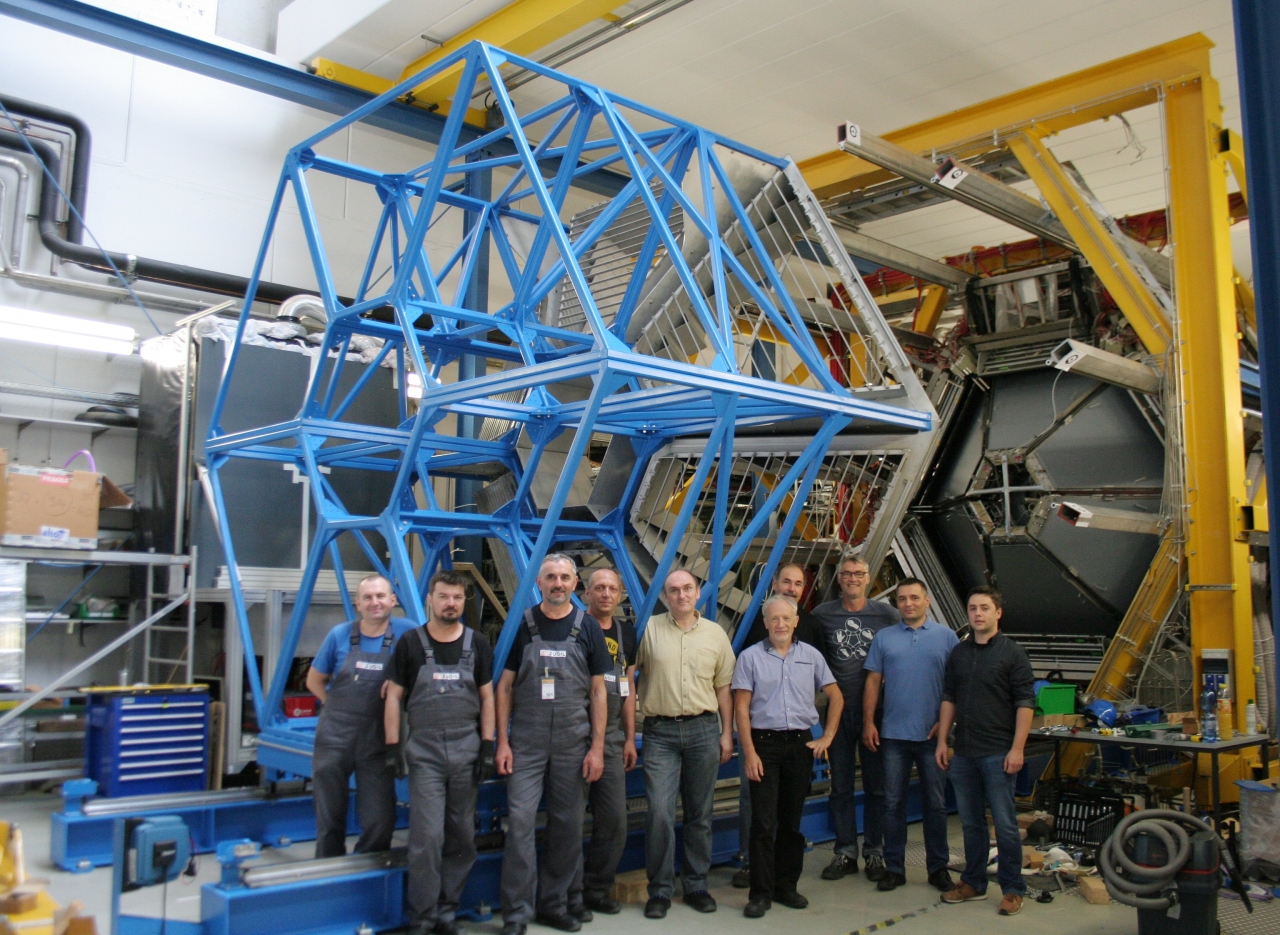Sie sehen momentan nur den öffentlichen Teil des GSI-Kuriers.
Um auch die GSI-internen Artikel angezeigt zu bekommen,
melden sie sich bitte an

Kurier - Mitteilungen von und für Mitarbeitende
Ausgabe: 39-2017 | 25.09. - 01.10.
Nachrichten
Nachrichten
Mainframe für den HADES ECAL Detektor wurde installiert

Quelle: E. Schwab
Letzten Monat wurde im HADES-Cave das Mainframe des neuen elektromagnetischen Kalorimeters ECAL installiert und damit wurde ein wichtiger Schritt gemacht, um mit HADES während der FAIR Phase 0 an vorderster Front Forschung treiben zu können. ECAL ersetzt den bisherigen PreSHOWER-Zähler und wird somit die Fähigkeiten des HADES-Spektrometers in zweifacher Hinsicht erweitern: 1. hochenergetische Photonen können nun direkt nachgewiesen werden, d.h. ohne den Umweg über ihre Konversion im Detektor-Material und 2. kann die Elektron/Hadron-Diskriminierung verbessert werden bei gleichzeitig erhöhten Zählraten. ECAL wird aufgebaut aus Bleiglas-Modulen vom vorherigen OPAL-Experiment am CERN LEP-Ring, die der HADES-Kollaboration vor einigen Jahren überlassen wurden.
Ein Techniker- und Physiker-Team aus NPI Rez, INR Moscow und der Jagiellonian-Universität Krakau überarbeiten momentan diese Module, um ihre volle Leistungsfähigkeit wiederherzustellen. Sobald alle sechs Sektoren bestückt sind, wird das Kalorimeter aus 978 Modulen bestehen, entsprechend einem Gesamtgewicht von 16 Tonnen Bleiglas. ECAL wird von einem FPGA-System ausgelesen werden, entwickelt von der GSI Experiment-Elektronik-Gruppe, in Zusammenarbeit mit HADES- und PANDA Kollegen von der GSI, der TU Darmstadt und der Uni Frankfurt.
Das ECAL-Mainframe ist ein "in-kind" Beitrag zu FAIR der Jagiellonian-Universität. Es wurde in Polen konstruiert und gebaut und in zwei Teilen zur GSI transportiert. Die sechs Strukturen, die die Bleiglas-Module aufnehmen werden, sind auf der Frontseite des Mainframes gut zu erkennen. Das ganze Mainframe steht auf einem Schienen-System, entsprechend dem, was später auch für das noch schwerere CBM-Experiment vorgesehen ist. Das Foto zeigt die polnischen Teams von der Krakauer Universität sowie der Firma ZUGiL S.A., die das Mainframe entwickelt und gebaut hat, zusammen mit den HADES-Ingenieuren (Erwin Schwab und Thorsten Heinz) und auch dem HADES-SIS100 Technischen Koordinator (Jerzy Pietraszko). Die HADES-Kollaboration nimmt diese Gelegenheit wahr, sich bei allen GSI-Mitarbeiterinnen und -Mitarbeitern zu bedanken, die dieses Projekt unterstützt haben und geholfen haben, es zu realisieren.
Mainframe for the HADES ECAL detector installed
With the installation of the mainframe for the new electromagnetic calorimeter (ECAL) in the HADES cave last month, an important step towards a forefront physics program with HADES during FAIR Phase-0 was taken. The installation of ECAL will enhance the performance of HADES in two ways: 1.) Photons can be detected directly without relying on their conversion in detector material and, 2.) detection of the expelling electron pair and the detector will replace the SHOWER detector to enhance the rate capability. ECAL is based on lead glass modules of the former LEP experiment OPAL. A few years ago, the modules were given to the HADES collaboration and will now be prepared for implementation again. A team of technicians and physicists from NPI Rez, INR Moscow and Jagiellonian University Krakow are currently reworking module by module to ensure optimal performance. Once all six sectors are equipped, the calorimeter will contain 978 modules weighting 16 tons. The calorimeter will be read out by a Field-programmable gate array FPGA system, whereby the Experiment Electronic department, along with colleagues from HADES and PANDA, will be occupied with the strategic development. The readout system for ECAL, which can be operated with rates up to 50 kHz, has been developed by the EE department together with HADES collaborators from TU Darmstadt, GSI and Goethe University.
The ECAL mainframe is an in-kind contribution to FAIR from the Jagiellonian University. It has been designed and constructed in Poland and was delivered in two parts. The six structures, which will receive the calorimeter modules, are seen on the frontside of the mainframe (unpainted). The mainframe is residing on a rail system using technology which is also foreseen for the heavy detector system of the CBM experiment and can be seen as a prototype of the CBM systems. The picture shows the Polish teams from Krakow University and the ZUGiL S.A. Company, who designed and manufactured the mainframe together with the HADES project engineers (Erwin Schwab and Torsten Heinz) and the HADES-SIS100 technical coordinator (Jerzy Pietraszko). The HADES collaboration would like to take the opportunity to thank all GSI employees who supported this project and helped to finalize it.
Prof. Joachim Stroth for the HADES Collaboration
Plasma physics lecture course on Equation Of State
Prof. Igor Lomonosov from the Institute of Problems of Chemical Physics of RAS will visit GSI from 26th September to 4th October 2017 for his lecture course „Introduction to equation of state of matter at extreme conditions“.
The course of lections deals with different aspects of EOS of matter under conditions of extreme pressure and temperature. We will discuss the EOS problem, motivation, examples of EOS importance for fundamental science and numerous practical applications. Experimental methods and theoretical models in EOS research at extreme conditions will be discussed. Methods of EOS calculations in practice will be presented along with examples of most common methods.
For information and registration please visit our Indico page: https://indico.gsi.de/event/6370/
D. Lang, Plasmaphysik / PHELIX, Tel. 2292
Die aktuellen internen Stellenausschreibungen finden Sie auch unter www.gsi.de/jobsintern
Gruppe PER-PAD










